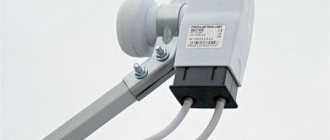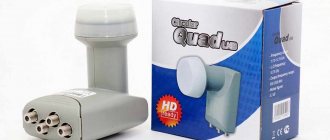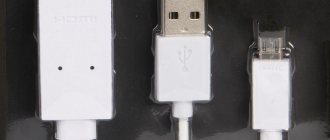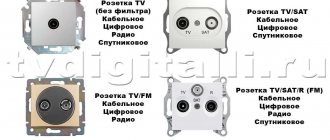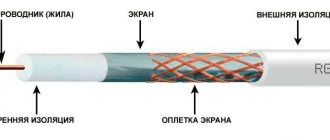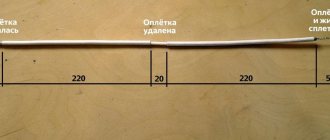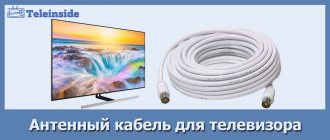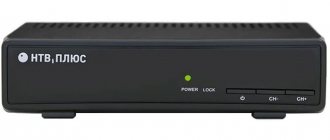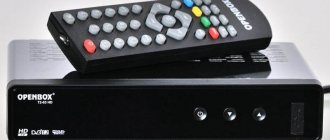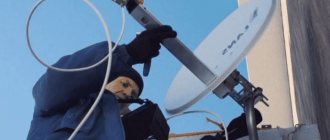Nowadays, the cable products market offers a large number of materials, each of which is endowed with certain properties and features. It is worth paying attention to coaxial cable, which is the most popular and has gained great popularity not only among ordinary craftsmen, but also among well-known construction companies. It is widely used when installing equipment designed to transmit high-frequency signals: television and radio broadcasting, video surveillance.
This type of product has high technical performance, and its use will extend the life of transmission equipment for many years. The material is durable and flexible, the foil screen together with the outer braid reliably protects the data.
This cable is easy to install
An example of high quality is the television coaxial cable from the Italian manufacturer Cavel. It simultaneously combines affordable cost and product versatility. In addition to a clear image, the conductor provides:
- Ease of installation. The thick and durable wire easily withstands light loads and pinches.
- The cable is not so easy to cut and break. The product is made to last.
- The connection to the equipment has good contact.
So, which TV antenna cable is best?
However, choosing television wiring is a responsible task. The quality of the picture, stability and durability of work depend on it. Although the structure of all types of such wires is the same:
In the center of the cable there is a conductor ( 1 ), followed by a polymer layer - dielectric ( 2 ), then an aluminum protective screen made of foil ( 3 ). Next is the second screen ( 4 ) made of intertwined wire (aluminum or copper). And all this is covered with a PVC shell ( 5 ).
Different cable models differ in the size of the central core, the number of foil layers and other features.
The conductor transmits the signal and power to the converter if the TV is transmitted via satellite. It is made from copper or steel, on top of which a thin copper layer is applied. A copper core is suitable for a satellite, and copper-plated steel can be used for other types of TV. The latter option is not inferior in picture quality, but costs less. The wire braid and foil shield protect against interference. It depends on them how good the TV signal will be received by the device.
The dielectric layer will protect the central wire from damage. It prevents the copper core from contacting the braid and screen. The outer sheath operates on the same principle, but protects the entire filling of the wire from external influences. The better it is, the greater temperature changes it can withstand, it will not be afraid of water or dust, and it will also protect against chafing. Cable types have their own indicators for each of the elements listed above.
The following wiring models can be connected to one or more TVs.
Repair work often involves a complete replacement of many technical elements, including television cables. The variety of media, the characteristics of antenna wires, thickness, markings, names... It’s not easy for an ordinary buyer to understand; specialists sometimes also look thoughtfully and for a long time at this impressive assortment. In order not to doubt your choice, we offer you step-by-step instructions on how to choose an antenna cable.
The cable structure is almost identical: there is a conductor or central core inside; Next comes the insulating shell, and a screen and braid are laid on top; at the end - a protective shell. A cable with this structure is called coaxial.
The internal conductor in any type of TV transmits the signal and also serves as a power source for the converter in satellite television. In the latter case , the main core is made of copper; for other options, a more budget-friendly core is ideal - steel with copper plating, the quality does not suffer. The plastic dielectric inside not only protects the central core from damage, but also reliably protects it from contact with the braid and screen.
The screen and braid protect against interference. The materials from which they are made can be different: aluminum foil or aluminum lavsan for the screen; copper, tinned-copper or again aluminum wire - for braiding.
The overall “packaging” of the cable is made of PVC; it protects against exposure to dust, water, and possible sudden temperature changes if the cable is laid outside the room. But the main thing is that it protects against mechanical damage.
Characteristics and brands of television antenna cable
Coaxial cable comes in different brands: RG-6, RG-59, PK-75, SAT-50, SAT-703, DG-113.
RG-6 cable
The RG-6 cable is a Russian brand made in China. The main core, 1.0 mm thick, can be copper or copper-plated steel, protected by a sheath of foamed polyethylene. The screen is made of foil, the braid is copper or aluminum. The outer shell is PVC. The overall cable thickness is from 6 to 6.8 mm; the most budget option for analog, cable and digital television.
Cable PK-75
Cable PK-75 is an analogue of RG-6, made in Russia. Copper central core 1.00 mm thick, PE dielectric. Screen made of single or double aluminum lavsan. The braid is made of copper or tinned copper. With a single screen it is recommended to use for cable and terrestrial television; with a double screen it will work perfectly when installing a satellite dish indoors.
RG-59 cable
The RG-59 cable is a thinner version of the already known RG-6 cable: the thickness of the main core is from 0.5 to 0.58 mm with an outer diameter of 5.4 to 6.0 mm. Advantage: suitable for transmitting all types of signals. Disadvantage: the distance should not exceed 200 m. The thinness of the conductor makes the signal weaker with each meter, which, of course, affects the image quality. This type is recommended to be used only for one medium, without connecting in a daisy chain circuit. In addition, serious bends in the wire can cause short-term operation and breakage of the conductor due to its thinness, and therefore fragility.
SAT-50 cable
The SAT-50 cable is manufactured by an Italian company and has good characteristics. Core – 1.0 mm; reinforced double-layer foil screen; copper-tin braid; the internal protective shell is made of PEG dielectric; external – made of excellent quality PVC; overall diameter – 6.6 mm. Transmits all types of signals - from terrestrial to satellite. The price, of course, is higher, but not radically.
SAT-703 cable
The SAT-703 cable is also manufactured by Cavel. The central core has a thickness of 1.13 mm; double-layer aluminum-plastic foil screen; copper-tin braid; PEG and PVC dielectric shells; The overall cable thickness is 6.6 mm. Reliable transmission of any signals; experts advise using this particular option for satellite TV, as well as when laying it outdoors.
Cable DG-113
The DG-113 cable also belongs to the Cavel brand, technical parameters are similar to SAT 703, however, the shielding coefficient is higher. Consequently, it better reduces its exposure to electromagnetic radiation from the external environment; high-frequency signals are transmitted without interference, the image is of only high quality. This is the most expensive, but at the same time the highest quality cable.
Which one is the best?
Professionals recommend the cable produced by Cavel, despite its higher price compared to other manufacturers. And for good reason: for more than forty years this brand has been considered a global brand - an example of excellent quality. It is impossible to earn such a reputation, thanks solely to PR - it gives an excellent mark to those products that, in practice, have won the right to be called a standard for impeccable performance and extended service life.
Which cable to choose for cable, satellite, digital TV
The question is often asked: is it necessary to select a specific cable for cable, satellite, or digital TV? Theoretically possible. But in practice, it is not at all necessary, because the frequency ranges of the channels are not critically behind each other. Although this range looks impressive - from 49 to 800 MHz, all the brands listed above confidently transmit the signal. Especially if the total wiring length does not exceed thirty meters.
Don't be confused by this universal approach. It really works. Of course, cables from Cavel inspire great confidence in the quality of the image. However, budget options can provide a good signal. This applies to digital and cable television.
The cable for satellite television requires special attention. After all, here we are talking not only about broadcast frequencies measured in thousands of MHz: it is clear that the rapidity of quality loss in the high-frequency range can be felt with every meter. We must not forget about special pulses, as well as the supply current of the converter local oscillator. And one more thing: satellite TV is sensitive to radio-electronic interference; more serious shielding of the antenna cable . And keeping in mind the location of the satellite dish outside the room, the question of a reliable outer shell that is resistant to weather changes, humidity, etc. becomes important. Experts recommend brands SAT 50, SAT 703, DG 113.
And here again we suggest paying attention to Cavel, optimal price/quality ratio, excellent service life, impeccable image. In general, the advantages of a branded antenna cable over an analogue one are that they are very durable and practically not subject to mechanical stress. This means there will be no problems with installation and further use. In addition, they ensure reliable contact in connections with plugs, sockets, etc. And, in the end, they just look very aesthetically pleasing. Which is important for the comfort of daily use.
If you still have questions about how to choose an antenna cable, our specialists will provide you with comprehensive information and professional advice in this area. We want the television cable you choose in our store to serve without interference, annoying misunderstandings, in a word - for a long time and with high quality!
Which cable to choose?
The best option is Cavel brand products. The Italians have impressive experience in the production of such products (47 years) and have earned recognition throughout the world. This antenna wire has proven itself in transmitting a digital signal. However, it is more expensive than other types, therefore, to save the budget, you can use domestic RK-75 or RK-50.
For satellite antennas, it is worth taking models with improved shielding. If you are laying a cable outdoors, pay attention to the stability of the outer sheath. High-quality wires are thicker, more reliable and provide stable contact with plugs and sockets. In addition, they are easier to install. Therefore, experts advise choosing more expensive models.
The structure of a television cable
Speaking about the internal structure, we can say with certainty that all models have similar content.
- Inner conductor - it can be made as a single or stranded wire, copper tube. The signal range and possible bending radius depend on the material.
- Dielectric layer – ensures the immobility of conductors. It can be made of polyethylene, fluoroplastic, foamed polyvinyl chloride or an air layer. The characteristic impedance and attenuation of the transmitted signal depend on the quality of the material.
- The outer conductor is braided. Made from foil, corrugated tube, aluminum film, metal wire. The degree of protection from external electromagnetic interference depends on the quality of the material.
- A sheath that protects the internal structure of the cable.
As you can see, the principle of cable structure is the same, but the materials from which its structural parts are made differ from each other. How to choose a good option that matches the technical characteristics of modern television broadcasting?
Tips for use
To avoid premature wire failure, adhere to the following recommendations:
- When choosing an antenna cable to your TV for residential connection, you should buy a model with high wave capacity.
- For outdoor installations in regions with extreme weather conditions (abnormal heat, excessive temperature fluctuations, increased precipitation, too low temperatures), choose wires with special impregnation.
- During the installation process, you should not make too many solders and connections, as this will negatively affect the quality of the signal. Laying a single wire is the optimal solution.
- You should not use home-made splitters; it is more advisable to acquire a proprietary device. In addition, splitters and signal amplifiers should be located in accessible places - it is possible that a breakdown will occur over time, and repairs will be carried out accordingly.
- During the installation process, follow the manufacturer's recommendations. This is especially true for the bending radius and the distance between fasteners.
- Under no circumstances should a coaxial cable be laid close to electrical appliances - this may cause interference.
The expert advice offered will help you make the right choice. As a result, you will achieve the highest possible quality of connection to television equipment.
Sources
- https://tehnika.expert/cifrovaya/televizor/vybor-televizionnogo-kabelya.html
- https://ProSmartTV.ru/tehnologii/koaksialnyj-televizionnyj-kabel.html
- https://prosmartv.ru/receiving/televizionnyj-antennyj-kabel-dlya-tv.html
- https://tvdigitally.ru/efirnoe-tsifrovoe-televidenie/kakoj-kabel-luchshe-sem-prakticheskih-sposobov-proverki-kachestva
- https://ProDigTV.ru/efirnoe/antenna/kabel-dlya-tsifrovogo-televideniya
- https://cifrovoetv-rf.ru/digital-television-cable-which-is-better/
- https://resiverplus.ru/kakoj-kabel-nuzhen-dlya-antenny
- https://vyborok.ru/qa/electronics/televizionnyj-kabel-kakoj-luchshe.html
- https://teleinside.ru/antennyj-kabel-dlya-televizora/
